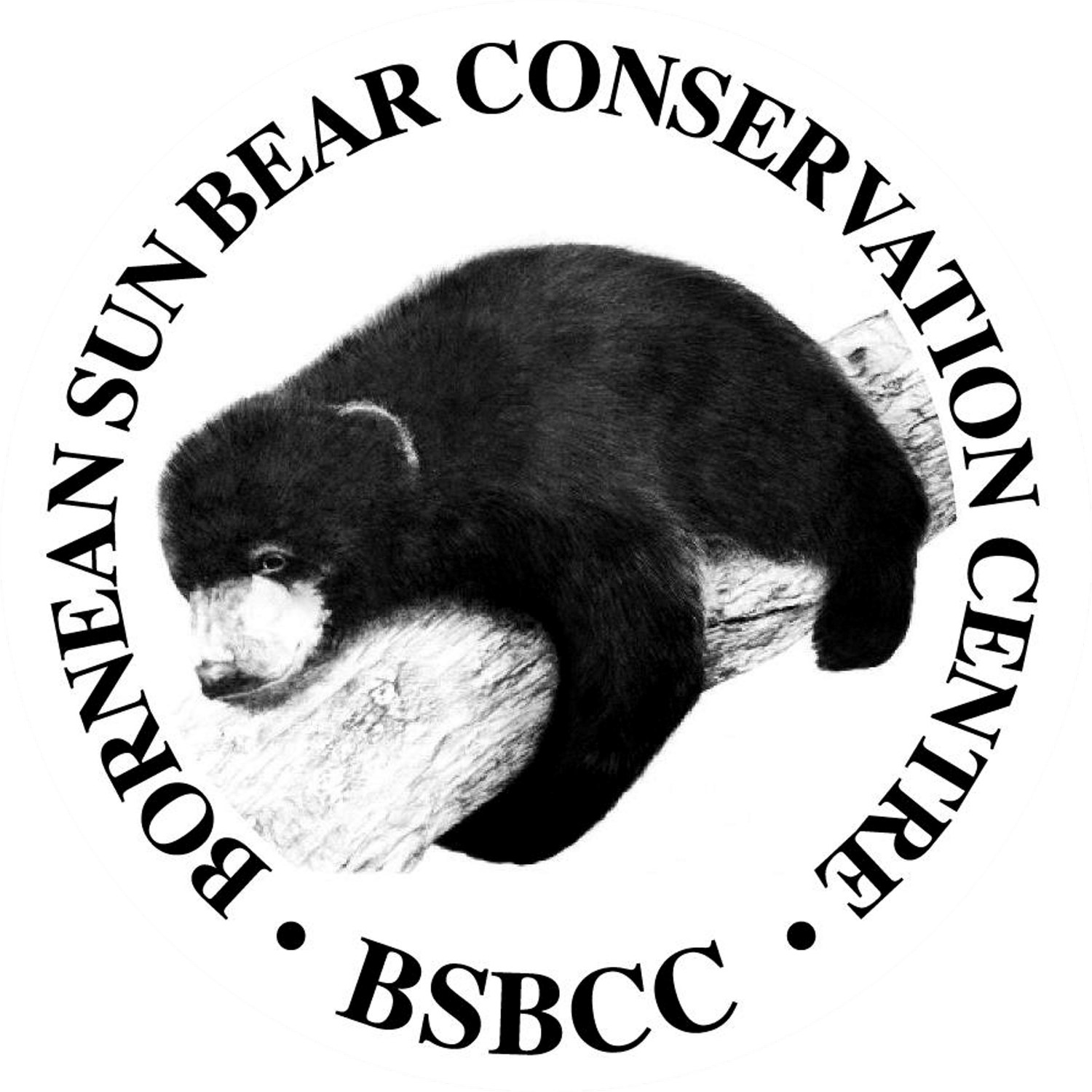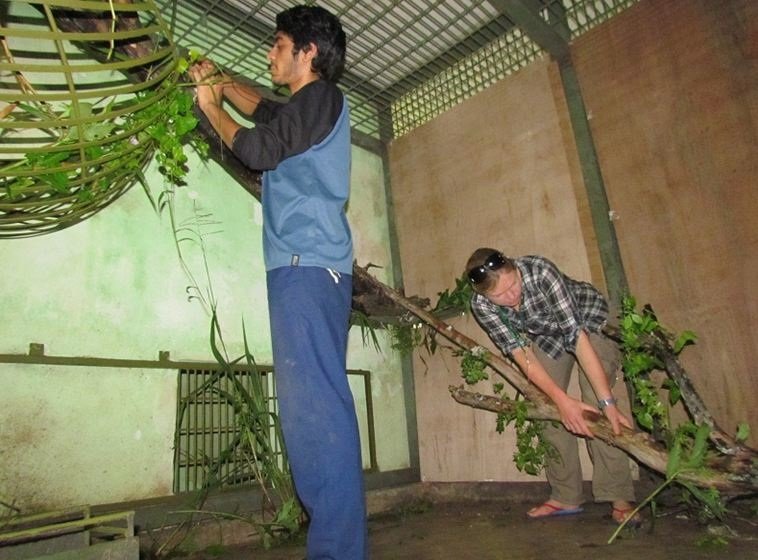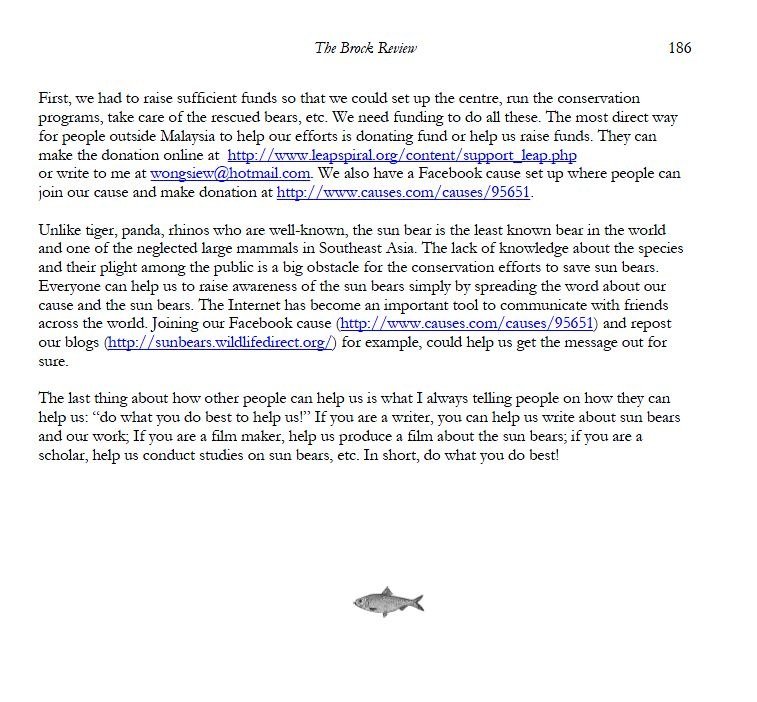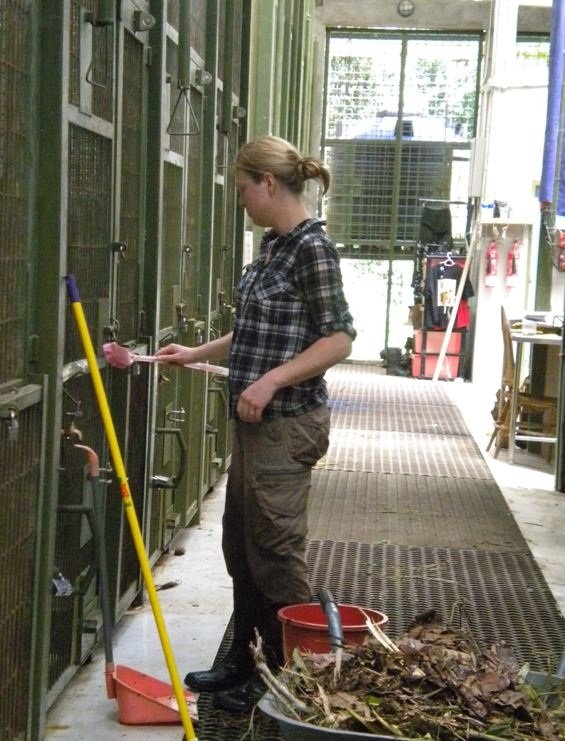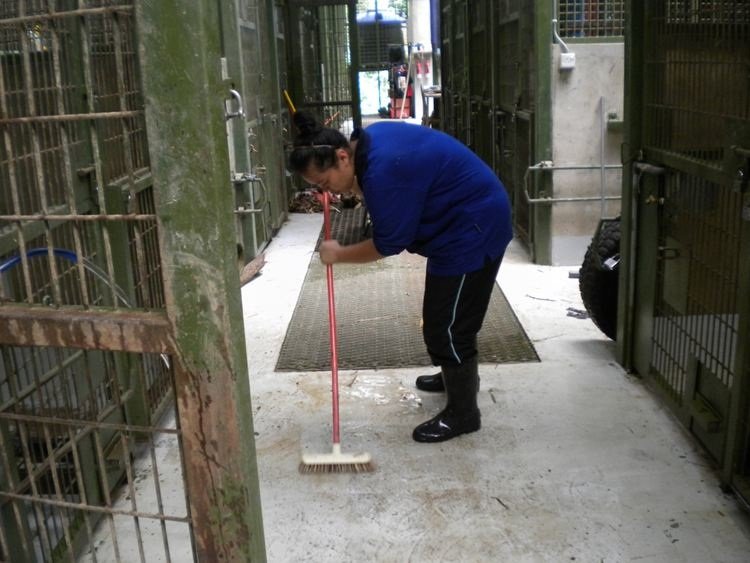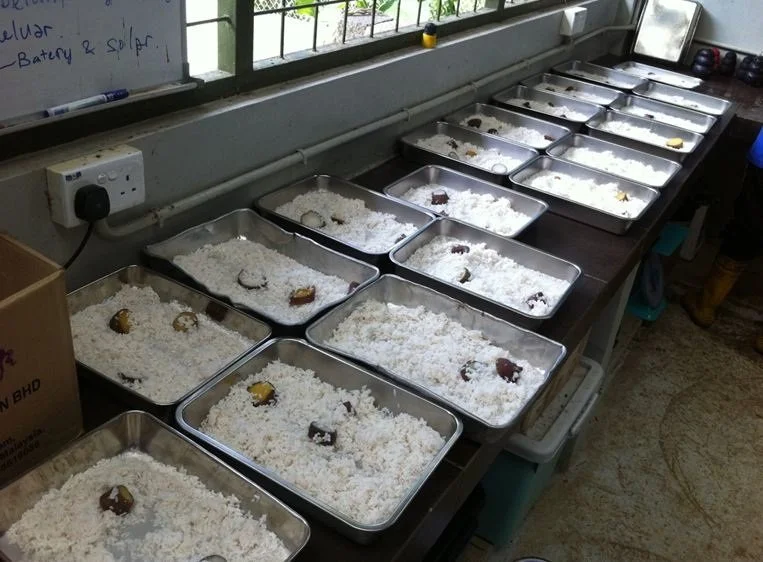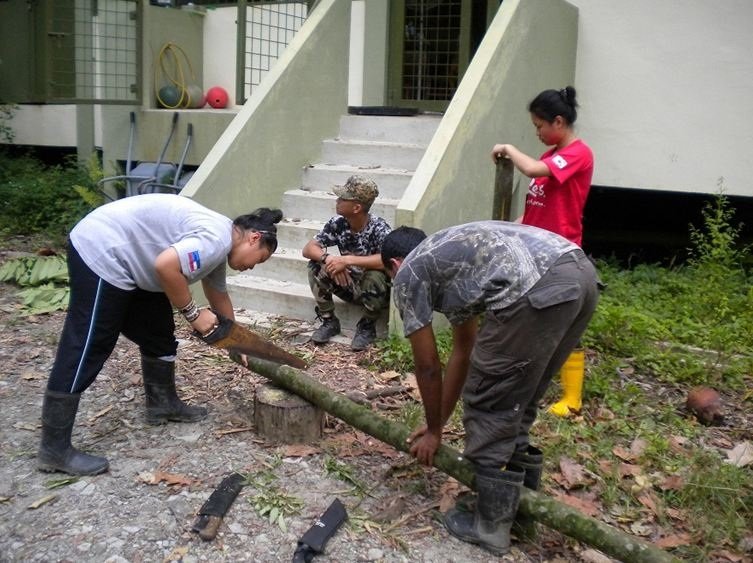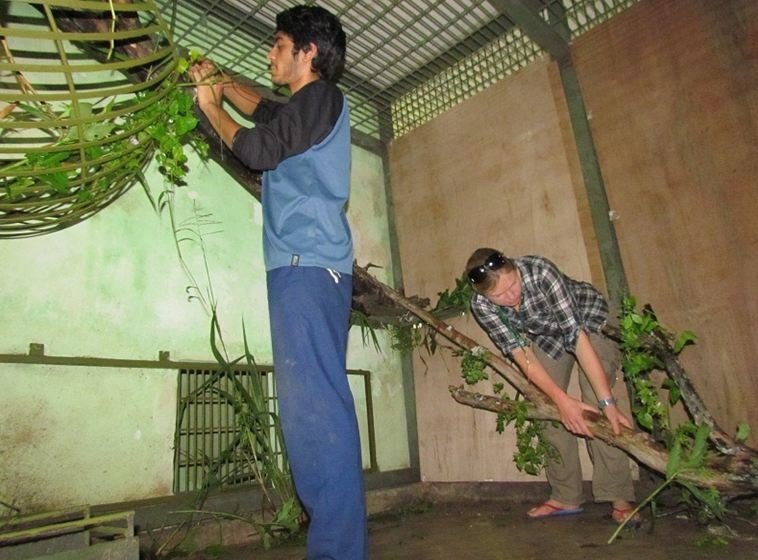A sun bear connection
It all begins with an idea.
Text by Alexander Montana Sethi
I have to sit and think back to recollect how long I’ve been here. Time has passed me and circled back and passed me again. I’ve gotten lost in the experience but I’m sure time is still running properly elsewhere. Its been three weeks since I’ve been here. My first two days were the last two days for the previous batch of traveller’s volunteers so my first night was a night out and second was their going away party. It was a great ice-breaker for me. The next day work started. I met all the bears but still memorizing names till now. I know all my favorites like Baby Foo (Fulung), Om, Nathalie, Manis, Kudat and Panda, and Amaco. Even through the small amount of contact we get, I've gotten familiar with quite a few and I think they can recognize me. Baby Foo, is the exception. He came after I did, and I’ve gotten closest to him because he’s still a baby and when he first arrived his bite wasn’t very strong. He arrived after my first week and in that time, we got to paint his cage and set up logs and a bunch of climbing equipment and hammocks (made of towels which he tends to rip through in a day or so now that he’s strong enough). When he first got here, his coat was rough and felt like a stuffed animal toy, but already with the diet he is on we can see his belly has gotten plumper, he is filling out, getting very strong, and his coat is nice and soft now that I want to pickup him up and play with him like he was my own cub.
Alex and Amy "enriching" the den of Fulung with branches and leaves.
Alex and Roshan preparing an enrichment item for Amaco the male sun bear. This time is a dead tree with lots of small branches tied up with vines. Hope Amaco like it!
I had no idea about conservation before getting here. I was always interested in animals and so volunteering on a conservation project seemed like the right choice for me. I am now so glad that I found Wong and the BSBCC because it has been the greatest experience so far. Its great to work hard and see the results, healthy animals. I stay until end of October with BSBCC then transfer to the Sepilok Orangutan Rehabilitation Center where I will work until December. Seeing as they have enough volunteers I would have liked to volunteer with BSBCC for my whole stay here but I had no idea about either organization prior to coming so splitting my time between the two seemed like the right choice. I have met most of the staff here and everyone has been quite welcoming. I’ve also made some friends that I'm positive I will keep in touch with after leaving. Amy, Wai Pak, Daniel, Roshan, to name a few.. So many people here and its such a community (with its ups and downs) but now that I've found my place I am very comfortable and happy and looking forward to enjoying each day. Work hard and the reward come naturally.
Alex tried to communicate with Fulung, a trans-species communication in progress.
Give Fulung a piggy-back ride.. Play time it is!
Beside the play time and fun time, cleaning time is for sure all volunteers do most!
An Interview with Siew Te Wong - The Brock Review
It all begins with an idea.
Sorenson, J. 2011. Interview with Siew Te Wong. The Brock Review. 12(1): 182-186.
The entire article can be download from:
http://www.brocku.ca/brockreview/index.php/brockreview/article/view/349/349
Mary the moon cake sun bear
It all begins with an idea.
WARNING:
Very cute sun bear baby photos.
SUN BEARS ARE PROTECTED BY LAW IN ALL RANGE COUNTRIES.
KEEPING SUN BEARS AS PETS IS A SERIOUS OFFENCE. YOU WILL BE FINE, IMPRESSION, AND CANE IF YOU DO SO!
***************************************************************
September 12, 2011 was the Mid-Autumn Festival, also known as the Moon Cake festival in Chinese Lunar Calendar. I was informed by the Sabah Wildlife Department in the morning that the Wildlife Rescue Unit will sent a baby sun bear to us at Bornean Sun Bear Conservation Centre. The rescue unit met us at the junction of Mile 32 of Sandakan Road to deliver the cub. Our team consisted of Wai Pak, Alex, Roshan and me. We left my house at 9 pm, when the neighbors were enjoying their BBQ Moon Cake Festival dinner under the full moon light on their porch.
The female sun bear cub, Mary, was surrendered by her owner from a small village near Ranau two days earlier. According to Mary's owner, Teresa, her husband and some friends went hunting on the night of June 17, 2011 in an oil palm plantation and "found" Mary at the forest edge. They capture her and brought her back home. The hunting party claimed they did not see the mother bear (do you believe it?). Mary was about 2-3 kg at that time. Teresa fed her with some milk (cow milk powder) the first day but stop giving her the milk because of her diarrhea problem. She was given a variety of fruits, rice, bread, honey, and some meat, but no milk in her diet.
The first meeting with Mary- in her transportation cage.
Three months later Mary was sent to BSBCC. The first time I saw on Mary I immediately noticed her abnormal looking: she has a relatively mature look relative to her small size. Typically, young sun bear cubs have short and round muzzle. However, Mary has a relatively long and pointy muzzle. Her body was relatively short and small. The next day I weighed her: 8.25 kg. I also noticed that she walks and moves very slowly. Cub her age (estimated 6 months old) should be very agile, playful, and active. Mary is not. Mary also likes to suck her right hind foot like all bear cubs that I have come across. She also likes to seek human fingers and suck them one by one. In addition, Mary's coat is brown, instead of sleek black, also a sign of abnormality.
I gave her some milk on the first night. This was her first milk in three months.
We suspect Mary's abnormal conditions (small body, slow movements, brown coat) are resulted from malnutrition and imbalance diet. She was also being confined in small cage that may restrict her growth. What Mary needs at her age was her mother's milk that rich in protein, fat, and other trace elements such as calcium, other minerals and vitamins, plus unlimited rooms for her body to grow. Without proper diet and sufficient space, Mary's growth was restricted and her development was disrupted.
Mary's relatively small body and slow movement may resulted from insufficient nutrients such as calcium in her diet and small space to grow in captivity.
I let Mary to suckle my finger to seek comfort. Suckling is an important part of bear cub development and growing process.Mary was given dog replacement milk formula and a variety of fruits and dog chow. She is house in a spacious cage. We hope she can catch up with growth under our care. In three weeks time we will integrate her with Fulung, another sun bear cub who is few months older then Mary. We hope both of these cubs can grow normally, healthily, and happily under the care of BSBCC.
Wai Pak used honey to lead Mary standing on the scale. She tipped the scale at 8.25 kg.
Mary has a habit of sucking her hind right foot to seek comfort. Self sucking is a common behavior display by orphan sun bear cubs for obvious reason - they do not have their mother to suckle or to nurse on mother's milk.
Mary's relatively small body and slow movement may resulted from insufficient nutrients such as calcium in her diet and small space to grow in captivity.
I let Mary to suckle my finger to seek comfort. Suckling is an important part of bear cub development and growing process.
Wai Pak give Mary a special treats to gain her trust- honey!
Mary enjoying her new den with many enrichment and toys!
Keeping sun bears as pets is a serious crime.
Please report to the authority if you see any illegal sun bears being kept as pets.
We got fans!
It all begins with an idea.
Yes, we got fans! Not just the fans (admires) fans, but fans that blow wind.
Under the tropical climate, daytime temperature in Sandakan area may get as high as 33 C. Few weeks ago, Amir Yussof, a good friend of BSBCC and a huge fan of the sun bear noticed that the air in the bear house was stuffy and hot. He asked why not installing some fans? "Tide budget" I replied. "Don't worry mate, I will come out with something!" He replied.
Sure enough, Amir started to come out with something: He contacted his friend, Nicola Stevens, the founder of International Aid for the Protection and Welfare of Animals (IAPWA). Immediately Nicky agreed to donate £500 for us to purchase some fans in the bear house to cool down our bears in the hot tropical climate.
We installed 3 ceiling fans and 3 wall fans from the donation given by IAPWA. Thank you!
Thank you Nicky, IAPWA and Amir, we now have seven fans installed in our bear house. These fans keep the air flow better and keep the bears comfortable! :)
Cerah the sun bear is enjoying her siesta high on top of her den.
The helps and generous donation from Nicky from IAPWA was one good example of what can you do to help us improve the welfare of the sun bear in BSBCC and help out work a lot easier to take care of them. Beside fans which are already being taken care of, we still need a list of equipments awaited your sponsors and kind support. If you have the interest to help us purchase the following "wish list" items for BSBCC, please contact me at wongsiew@hotmail.com.
BSBCC's Wish List:
2 x Water jet cleaner - RM 1500
Washing machine RM 1200
Desktop computer RM 3000
Animal Electrical weigh - RM 2000
Power drill - RM 800
2 X Transportation cages @ - RM 2000
Welding machine - RM 1000
4 x Stainless steel water tank @ RM 1500
Laminating machine - RM 500
6 x Walker-talki @ RM 1700
Thank you!
Big Dream Little Bears
By Howard Jackson and Dr Audrey Low
After a year and half’s work on our documentary witnessing the pivotal moment in Wong’s big dream for his little sun bears we decided it was close to completion and high time to test it on an audience. The Sydney Film School where Howard works was kind enough to offer their screening theater and so we set about inviting a wide cross section of people to see our big dream little film. Normally, with a preview, all the principle team; the producer, publicists, designers, marketers, sponsors, investors etc, etc…and the film makers; director, camera, sound, editor, talent, narrator, colorist, score composer etc, etc, etc, fill half the theatre. But for our film (our big dream no budget as we’ve come to call it) has a sum total of 2. The thank-you’s and congratulations and stroking of one another’s egos, were therefore mercifully short.
It was an evening screening but we made it a point to let people with children know they were welcome and so in amongst the heads of university departments, Borneo experts, professors, our Sydney sun bear expert (Lesley Small), a small smattering of film makers, educators, advertising people, animal lovers and members of the general public; we had a dozen or so kids ranging from four years old to twelve. Some looked fidgety and bored before we had even begun our introduction and we couldn’t help thinking it could only go downhill from there.
The lights went down, the title came up and within the first minutes the kids had settled and were giving the story their full attention. We hadn’t really considered this film to be something that would engage children so I have to admit we expected them to lose interest after a while but against all expectations they sat with their eyes glued to the screen for the full 52 minutes and 38 seconds.
As filmmakers you tend to judge the audience appreciation (or not) by the sounds and movements throughout the theater. The right ones came pretty soon after the film began: a nice series of chuckles and outright laughs at the interchanges between Wong and the international bear crew and the oughs during the darting and medical procedure. I noticed someone almost jumped off their seat when the first bear was zapped by the electric fence and the macaques stealing the bear’s food were a special favorite. Towards the end a distinguished professor called out “Oh no, she’s not going to go” when it looked like none of the bears would ever leave the cage and then when it happened called out again “Good on you girl.”
In short the audience reaction exceeded our best expectations, and certainly exceeded our worst. The kids were doing Wong’s slow motion “Free the bears” impersonations in the foyer (if you haven’t seen that, it’s on the Wildhoop youtube channel). The question and answer time at the end, normally a polite formality went on so long we finally had to say we surrender and that we wanted to get to the food and drink we had prepared.
One of the heartening aspects of the screening for the BSBCC was the number of people who came up to us afterwards, whist sharing a beverage or two, to ask us how they could help or donate to the cause. The fact they could see where the money was spent and that Wong and Wai Pak, and the people dedicated to Malaysian conservation, were making a difference, or put another way, they could see hope, really struck a chord with people. It also surprised them to learn that you could build a purpose built facility in Malaysia that cost around about the same amount as it takes to fund a fairly low budget documentary.
It has been a fascinating journey for us. We originally went to Sabah to shoot some footage so as to put up a clip on the web to help publicize Wong and the BSBCC and at the same time to use the clip to try to get film investment here in Australia so we could go back with a crew to make a slick documentary. The first part of that plan was a resounding success (we’ve had just short of 50,000 hits on Youtube alone), the second part, wasn’t quite a resounding victory. Insisting we feature the team of people working on the bears without superimposing a western presenter in front of them was never going to help get investors. But, like Wong, we weren’t going to give up. We looked back through the footage we had shot and realized there was a stand-alone story within. Well, we hoped. It’s hard to tell until you put in front of a real flesh and blood audience.
Doing every job between two people is a long and tiring process, we’ve had to stop occasionally to go out and teach so we could start the next stage, but having a close to completely finished project within the time we’ve taken is about what it takes for a production house.
Since the great response to the Sydney Film School screening we’ve had an offer to show it in Melbourne at another film school and, both interestingly and coincidentally, after our surprise at Big Dream’s success in entertaining kids, we’ve had a distribution offer that could see the little bears be viewed in schools and universities (with an education pack included). The film was described as moving, inspiring, and perfect for young people. We’re still in negotiation but it does show that Wong’s belief, if only people knew the Borneo sun bears exist, they would be interested and love them.
We’re almost there, just few last tweaks to sort out the broadcast specs, (the first time we’ve encountered something we can’t do or learn to do ourselves), but we are ever so close to having the dream ready for audiences to join Siew Te Wong and his fantastic team on their quest to save one of Borneo’s rarest and unknown (hopefully we can do our small part to help to change that) treasures.
Future plans? Obviously this process has sent us stark raving mad, we keep dreaming of going back to Sabah and doing another one. Anyone working with animals that no one has ever heard about and no film company would ever invest in. Contact the two crazies at Wildhoop Productions.
++++++++++++++++++++++++++++++++++++++++++++++++++++
[kml_flashembed movie="http://www.youtube.com/v/bqYRr_pO_44" width="425" height="350" wmode="transparent" /]
Wong's note:
Thank you Howard and Audrey so much for accomplishing such a tremendous task for "making" (producing, directing, filming, editing, narrating, ............) Big Dream Little Bears. I would never have thought that this project has come this far. I still recalled clearly the first email that Audrey wrote me and offering help few years ago. "Do what you do best to help us" was my replied. True enough, Audrey said her husband is a film maker and can help us make some videos to promote our course. The end result is much better! Big Dream Little Bears is a great gift from Howard and Audrey and Wildhoop Production to me and BSBCC.
This is a great documentary that recorded what was happening during the few weeks when we moved the sun bears from the old bear house to the new bear house. We now can always remember every single detail - including the continuous sneezing from my allergy to sun bears.
Thank you Howard. Thank you Audrey. Thank you Wildhoop Production!
A Day in the Life of a Sun Bear Volunteer
Text by Amy Scott
Photos by: Ng Yen Fern, Marieanne Leong, Amy Scott and Ng Wai Pak.
I have just returned to Australia after spending almost 2 months volunteering at the Bornean Sun Bear Conservation Centre in Sepilok, Sabah on the island of Borneo. I arrived at Sandakan airport on July 6th and was met by a smiling Wai Pak the BSBCC project manager and Marieanne and Fern two Sabahan volunteers whom I was to enjoy several weeks living and working with. We then did a few necessary bear centre errands, banking, shopping, a trip to the post office etc before heading back to the centre in Sepilok about 20km away where I met other volunteers, Venda and Roshan, and hard-working bear keepers David and Daniel. It was also my first meeting of the sun bears. I guess the first thing I noticed, that I wasn’t expecting, was how agile the bears were, like monkeys - climbing all over the cages and on the tyre swings and branches including upside down. It was very entertaining to watch! This was just my first day and I didn’t know then what a great experience was ahead of me.
Me with fellow volunteers, Venda and Roshan, and bear keeper Daniel.
We all stayed at the volunteer house with Wai Pak about 5 km from the bear center in a lovely rural setting. The house is a large old double story timber house with 3 bedrooms and living room/office upstairs, and downstairs the kitchen, eating area and bathroom. I came to love the house, particularly its open air style and surroundings of banana and palm plantations and an orchard of limes. I enjoyed watching the geckos in my room moving about and catching insects, and the front balcony was a great vantage point for watching amazing electrical storms and also squirrels and birds darting about in the palms next door. We had as many limes as we liked for making ‘lime cordial’ and also chilies for cooking and we enjoyed many of Wai Pak’s great creations in the kitchen (and while we’re on the topic of good food, BSBCC CEO Wong certainly makes a superb dumpling amongst other dishes! J).
Wai Pak cooking up a storm!
Another delicious meal.
The volunteer house.
So what does a ‘typical’ working day at the Bear Centre involve? Of course a typical day is not always typical but usually Wong would pick us all up at the house at about 8.00am and after a quick breakfast at the Sepilok cafe, of normally Mee Telur (noodles and a fried egg) and a Kopi Nai (coffee with condensed milk) we would start work at the ‘new’ bear house about 8:30. After greeting David and Daniel and a bit of pre-work ‘cheeky banter’ it was time to change into our rubber boots (gum boots if you’re an Aussie) and start the first task of the day washing the 22 trays from the bear’s early morning rice porridge breakfast. These are disinfected, scrubbed, rinsed and stacked for drying.
Next the fun commences! – The cleaning of all enclosures in the main bear house: Sweeping up piles of bear poo and old and wet leaves and grass, scrubbing and hosing floors and walls squeegeeing the floors dry and scrubbing of water troughs. New foliage, vines, and branches are then collected from outside for distribution around each newly cleaned enclosure.
The next task for the day is cutting fruit for the morning fruit feeding. A combination of fruits and vegetables (but majority fruits) are given twice a day to the bears and can include apples, oranges, snake fruit, corn, bananas, papaya, corn, cabbage, beans and water melon.
The morning fruit feeding is at about 11:00 and the afternoon feeding about 2:00. Fruit is scattered and spread around enclosures to promote more natural foraging behavior. After the morning feeding, fruit is chopped for the afternoon feeding and put into large bowls in the fridge over lunch. Rice, for the afternoon rice porridge meal, is also put onto cook in two large pots. Then it’s washing of bowls, knives and chopping boards and a general tidy up of work area before lunch.
Me scrubbing, scrubbing, scrubbing!
Venda sweeping, sweeping, sweeping!
Marieanne cutting fruits.
Preparing rice porridge for the bears.
Trays of rice and sweet potato cooling ready for the afternoon meal.
After lunch the rice is served out into individual trays for each bear to cool down prior to feeding at 4pm. Sweet potato or raw egg are mixed with the rice on alternate days. The afternoon fruit is then fed along with cleaning and collecting of foliage for the ‘old’ bear house. *The ‘old’ bear house is the original bear house (also includes quarantine for new bears) and the main or ‘new’ bear house where most bears now live was completed in 2010. Funding for an additional bear house is underway and when completed, bears from the ‘old bear house’ will be moved here.
Following cleaning of the old bear house time is often spent in the afternoon preparing enrichments for the bears and a large part of the volunteer role at the BSBCC involves undertaking tasks that provide environmental ‘enrichment’ for the sun bears while they are in their cages in the bear house.
Enrichment is the process of providing stimulation to an animal in an unnatural situation such as when in captivity that provides a more natural environment and promotes normal behaviors and activities. Enrichment also attempts to reduce repetitive or stereotypical behaviors that can be observed in animals that have been kept in small enclosures for extended periods with no stimulation. Many of the bears that arrive at the BSBCC have been in this situation.
In a wild situation sun bears will spend a lot of their time on the move, foraging for food, digging and climbing. They will interact with the natural environment experiencing different smells and sounds and come into contact with a variety of plant and animal species and different terrains. The BSBCC is the only sun bear center in the world that has natural rainforest habitat for the bears to roam, and seeing the bears digging, foraging and exploring their outdoor environment and just acting like wild sun bears was definitely one of the highlights for me at the center. However due to several reasons including current space limitations as the bear center expands and new bears keep on arriving, not all bears can be outside in the forest enclosures at the same time so providing enrichment to the bears while they are in their cages in the bear house is an important part of the BSBCC program. The main aim of the enrichment process is to provide as many elements as possible of bear’s natural habitat and then provide other sources of stimulation for the bear’s senses that provide extended periods of activity and interest. The longer the enrichment keeps the bears busy and interested the better!
There are various categories of ‘enrichment’ that can be provided and some of the ‘habitat’, ‘physical’ and/or ‘sensory’ enrichments prepared and provided to bears at the BSBCC include:
Piles of dried leaves and grass for foraging, play and bedding for the nest basket and stimulation of senses particularly touch and smell.
Foliage, braches and vines including edible and non-edible species that provide both food, shelter, bedding and in general a more natural environment providing different textures, tastes and smells.
Large logs and tree stumps for climbing, resting on and tearing apart with their claws.
Water baths for wallowing and playing in - sun bears love water!
Tyre and wooden swings and hammocks for climbing, play and resting and to provide vertical structure to the enclosure.
Collecting branches.
Making a bamboo swing for little Natalie.
Myself and Alex (volunteer/ Bollywood dance extraordinaire) preparing a cage, with climbing structures and various types of foliage for the arrival of Fulong, a small young male bear that arrived a couple of weeks before I left and who is now I’m sure, growing big and strong.
Food enrichments included:
Scatter feeding and hiding of fruits around the enclosure in different structures and at different heights to promote natural foraging behavior and extend feeding periods.
Filling ‘Kongs’ (strong rubber dog toys) with banana, one of the bear’s favourite foods- Kongs have a hole in the center and the banana is packed in tight. The Kongs are then thrown on the roof of the cage and the bears quickly climb up to take a look. It takes some skill and ingenuity by the bears to pull the Kong through the bars inside where they can then scoop out the banana with their claws which again keeps them busy for a while because the hole is small and their paws are big!
Large water ice blocks filled with various foods including fruit and/or corn and dry dog food are a favourite of the bears. Being large, solid, frozen and slippery it takes some time for the bears to access the food inside and keeps their interest for ages which is the objective!
Fruit ice blocks.
Whole coconuts provide the bears with activity and interest for quite some time, eventually cracking them open with a combination of their powerful teeth and by throwing the coconuts against the walls and floor. Once they have made a hole they drink the juice by holding the coconut between their feet and lying on their backs and then break open the rest of the coconut to eat the flesh- Quite a treat to watch!
Sections of bamboo or PVC pipe are packed tight with fruit and grass and thrown on top of cages. This provides a two part enrichment one is the difficulty in accessing the food while the pipe is outside the cage which again takes some skill, and the second is ripping apart the empty bamboo case (and sometimes the PVC pipe!) which some bears take great delight in doing!
Other than the husbandry work we also conducted a couple of small studies and some field work while at the BSBCC. The first involved an assessment of trees within forest enclosures to see which trees are preferred by sun bears for climbing, and which characteristics led to this tree preference, e.g. height, species, canopy cover etc., (see blog http://sunbears.wildlifedirect.org/2011/07/15/the-joy-of-working-in-the-forest-the-volunteers-diary/).
The second was a small gut passage rate pilot study, which involved mixing seeds (dried beans) with the food of several bears and recording how long seeds took to pass through the gut of the bears. This information could contribute towards learning more about the role of sun bears as seed dispersers in the rain forest and it is hoped may lead to a larger student project in the future.
I also undertook some bear behavioral monitoring over a period of a week in August spending a few days in both the ‘new’ and ‘old’ bear house that involved recording what activity each bear was performing every 5 minutes from various categories of ‘natural’ and ‘stereotypical’ behavior. It is a good technique to determine the rate of natural compared with stereotypical or non-natural repetitive behaviors that bears are performing and help with identifying which bears need more enrichment and how bears are improving over time that they are at the center. I found this to be a very interesting little project learning a lot more about sun bears and their behavior.
The Bornean Eco-Film Festival was on in Sandakan in July. It showcased a number of environmental documentaries many filmed in Sabah and highlighting local environmental issues. It included the Bear Trek film Promo showing the work of bear researchers from around the world and featured Wong undertaking his research on sun bears in Danum Valley which was fantastic to see. Wong also did a presentation on the BSBCC and issues facing the sun bears that was very well received by the audience and hopefully will lead to wider awareness of the plight of the sun bears.
I very much enjoyed my time at the BSBCC and in Sabah and met some great people and gorgeous sun bears which really are the most remarkable animals! At the same time I learnt a lot about sun bears and the threats they are facing now into the future and why they need our help so much. It was a great experience for me and I highly recommend it to anyone! Thanks Wong, Wai Pak, Daniel and David and all the volunteers I worked with for looking after me so well and to the sun bears for making it such a wonderful experience!
The very handsome Om exploring his forest enclosure.
At Last!
By Paul Clenton
Repost from http://bearingupinborneo.wordpress.com/2011/09/19/at-last/
Yesterday was monumentous for me as I finally got to meet up with Anna Cocker. It was very exciting for me to meet her because I have heard so much about her in the past had taken us months to find a mutually-convenient time and place to get together, but I’m very glad that we did. Anna is an amazing person who has earnt her stripes at the BSBCC through contributions made at both Sepilok and Danum Valley, aswell as through her efforts to raise awareness and funding in the UK.
Anna radio-tracking in Borneo.
It was great to talk to someone who shares my enthusiasm for sun bears and their conservation. We met up at Stafford Railway Station and went for a “Beartrek” around Cannock Chase. We spent 6 hours in constant conversation about the the bears, life in Borneo and the people and places we knew; even Wai Pak’s dog got a mention! It was probably ‘good therapy’ and certainly very motivating for both of us.
Like myself, Anna has done sporsored events and given talks on sun bears; there is much that we can learn form each other by pooling our experiences. Single-handedly raising awareness for sun bear conservation can be challenging, especially when day-to-day life gets in the way of things, so I think it will be highly beneficial for us to work together and share our ideas on how to accomplish this.
Anna and I have aggreed to get together again in a few weeks to further discuss our plans to get the Sun Bear Conservation Trust back on track and firing on all cylinders. I have a strong feeling that something good is going to come of this.
++++++++++++++++++++++++++++++++++++++++++++++++++++
Wong's notes: if you are from UK and would like to join Sun Bear Conservation Trust, please contact Anna Cocker : <annaecocker@yahoo.co.uk> or Paul Clenton pdclenton@yahoo.com.
NO, you cannot keep sun bear as pet! Take 2
Recently I am dealing with several cases of pet sun bear cubs. Among them are Fulung, Bunbun, Mary (we rescued this cub 3 days ago, stay tuned for her story), an unknown sun bear cub in West Malaysia, and this morning a reader from my blog asked me "where can I get one of these bears for myself?". My answer to him was crystal clear: "No! You cannot get a sun bear for yourself!! It is a serious offense if you do. You will be fined, jailed, and caned if you do! Probably burn in hell too!"
No, no one can keep a sun bear as pet! Absolutely no one!
Sun bear is listed as "vulnerable" in the IUCN Red List of Threaten Animals. They are an endangered species. They are protected species by both national and international laws. In all range countries where sun bears are found, there are local and national wildlife protection laws that prohibit any one from killing, capturing, selling, keeping, harassing, etc., of sun bear. In addition, there are international laws like CITES (Convention on International Trade of Endangered Species) prohibit any illegal trade of sun bears and their parts between countries. In short, YOU CANNOT OWN A SUN BEAR AS PET!
Why can't you t own a sun bear as pet, although they are small, so cute, and super cuddly?
This is why YOU CANNOT OWN A SUN BEAR:
1) Protected by Law: Like I mentioned earlier, they are protected by law no matter where you are! In Malaysia, offenders can be fined up to RM100,000, jailed 5 years or both.
2) Dangerous I: Sun bear is a wild carnivore. They are very strong and equip with large canines and sharp claws that can do a lot of damage. In the wild, they use their strong claws and canines to break termite nests, and bee hives, even the bee hives that are found inside iron wood, one of the hardest wood in the world.
3) Dangerous II: They are wildlife that cannot be tame. The domestication of dogs and cats took thousands of years and generations. If you think you can tame a wild caught sun bear (even if it is a cub), I advise you to think again.
4) Sun bear serve important ecological roles such as seed disperser, ecosystem engineer, forest doctors etc., in the forest ecosystem. By removing a sun bear from the forest to captivity, you eliminate the important roles they will play in the forest.
5) Fuel wildlife market: By buying a sun bear as pet, you fuel (encourage) the wildlife pet trade market. You will encourage more people wanting to keep sun bear as pets. There will be more poachers looking for sun bear cubs in the forest. These poachers often have to kill the mother bears in order to capture her cubs. In addition, there will be more middle man to trade sun bears as it is a lucrative business.
6) Ethically and morally wrong: sun bear is part of the forest ecosystem in SE Asia. They evolve and survive in these forests for the past 5 million years. They have every ethical rights, ecstatic and intrinsic values to be part in the forest ecosystem. Any actions that result the killing, extirpation of the bear from these forests are therefore ethically wrong.
Bornean Sun Bear Conservation Centre is set up because of many sun bears being kept as pets. (Read more at http://sunbears.wildlifedirect.org/2008/05/07/bsbcc-%e2%80%93-how-did-it-all-begin/). At first it was fun to have a super cute sun bear in your house. However, as a bear, they have to grow fast and grow strong quickly to face all the challenges to survive. After several months, they grow big, become so strong and aggressive to a point their "owner" (they like to be called as a bear lovers) cannot handle them because they become too dangerous to be a "pet". Al this point, there are often 3 options happen to the bears: a) make some money from the bears by killing the bears and sell their body parts, b) continue to keep them in small cage, and c) surrender to the authority. Regardless of what options, the life and the faith of the bears are mean to be doomed and worst them doomed. They are in hell!
Read the 3 parts blogs that I wrote few years ago:
http://sunbears.wildlifedirect.org/2008/06/09/captive-sun-bears-series-i-because-they-are-cute/
http://sunbears.wildlifedirect.org/2008/06/14/captive-sun-bear-series-ii-life-at-young-in-captivity-the-suffering-begin/
http://sunbears.wildlifedirect.org/2008/06/20/captive-sun-bear-series-iii-life-in-hell/
After BSBCC was established 3 years ago, we have rescued 26 caged sun bears. Few days ago one of our volunteer asked me if I was happy to have Mary our latest rescued sun bear cub. I do not know how to answer her. I was not happy at all to see these bears being rescue. How can I possibly be happy if I know their mother was killed, habitat being destroyed, although she was so sweet and cute sucking my finger. I am glad we rescued her and she end up under our care in BSBCC. I can only be glad, not happy, that Mary is here. If you notice, my smiley face has long gone after I set up BSBCC because every day I see these rescued bears in BSBCC. Most of them definitely look happier and are definitely are happier than before. To me, I can only be glad but not happy because I know the sad and sorrow stories behind each and every one of our bears.
Please, do not keep sun bear as pet, if you are mentally normal and warm blooded!
Please, report any unlawful of keeping, killing, and trading of sun bears and its parts to the local authorities!
Please, help us spread the words and raise conservation awareness for this little forgotten bear!
~ Siew Te Wong
The Story of Fulung - Part 3
Fulung finally arrived at BSBCC at 10 pm on August 15th after a long 7 hours on the road from Lok Kawi Zoo. He appeared to be healthy and active, but a bit skinny and malnourish by weighing only 7.8 kg. He was considered under weight of a male sun bear cub of his age. His forehead has a patch of scar from rubbing against the bamboo and wooden cage where he used to be kept. All of his canines were not grown and other permanent teeth were not fully grown. All of these signs indicated malnourish and imbalanced diet, a common condition among the most of the captive sun bear cubs we have come across. The malnourishment resulted from the lack of sufficient knowledge on caring infants or cubs and most important lack of bear's milk to feed the bear infant or cub that is high in protein and fat.
Fulung's condition slowly improve on a daily basis. He is a playful sun bear!
Fulung exploring the new climbing structure in his den.
Fulung settle down slowly at BSBCC. We place him at a quarantine cage for 30 days to ensure that he is healthy and free from any diseases. During these 30 days he will have no contact with other bears. The first few days he was showing signs of stress, nerves, and fear in the totally new surroundings. He would calm down when we were around to play and to attain him. However, when we were not around, he would cry out and roar loudly to seek people's attention. We tried our best to stay with him and play with him as much as we could. After several days, his condition improved. He seems to getting more relax and confidence to the new environment and play a lot by himself with the enrichments and toys that we gave him. He did not cry nor roar like before. His appetite greatly improved and also gained weight on a steady pace.
Fulung enjoying his new bed- a hammock, but he destroyed it few hours :( Well, that's what sun bear do best- destroyed!
Fulung is growing well, very well indeed. He is now 15 kg, almost doubled his weight since he came here almost a month ago. The scar of his head healed and hair slowly growing back. He is very playful and stays active most of the day. He usually plays by himself except when he was taking nap. We hope Fulung will grow healthy and big. Soon we will walk him in the forest.
Fulung eyed on his new bed high up on his den.
New bed! High on top of his den.
Fulung slept on his hammock made from towel when he was in his temporary cage.
This is what he did to me when I woke him up!
The story of Fulung - Part 2
Photos credit: Colleen Tan
***************************************************************
WARNING:
Very cute sun bear baby’s photos.
Yes, Fulung the sun bear cub is VERY cute!
NO! You cannot keep a sun bear baby as pet! Please report to the authority if you see any illegal sun bears being kept as pets.
***************************************************************
In the next few days, many phone calls and emails were made among BSBCC, Sabah Wildlife Department, Colleen and her boss Md Eleanor Wong. The plan is to rescue Fulung and bring him to BSBCC. Nooh, the owner of Fulung, also came down to Kota Kinabalu the capital of Sabah, to deal with the surrender of the sun bear cub and the paper work needed for such surrender.
On August 10th, a rescue operation was organized by the Wildlife Rescue Unit of the Sabah Wildlife Department. Colleen, Nooh and the Sabah Wildlife Department Veterinarial, Dr Rosa, were in the team. They started their journey from Lok Kawi Zoological Garden near Kota Kinabalu around 10 am to Long Pasia. After a quick lunch at Sipitang, a small cowboy town closest to Long Pasir, the team continued their journey. While at Sipitang, Nooh heard from his brother saying that Fulung nearly die in Long Pasia because Fulung "missed" his owner so much to a point that was not eating any food for 3 days. Nooh's son who was in Long Pasia told Fulung, "father in KK and fulung eat a bit, a bit :-P. The father in KK always woke up at 4am thinking of Fulung" This was real story I was told !!!
The journey from Kota Kinabalu to Long Pasir took about 6 hours on bad dirt road that was bumpy and slow.
After a quick rest at Nooh's homestay for hot coffee and chit chat, the rescue team and Coleen left Long Pasia around 8 pm. Nooh said good bye to Fulung and told Fulung to be a good bear when he moved to the new place soon. There will be a new owner taking care of him. The rescue team rested at Sipitang town at 11.45 pm. Fulung has 2 pack soya drink. Finally Fulung and the rescue team reached Lok Kawi Zoo at 2 am where he stayed for few days to do some medical check up and observation before he was sent to BSBCC.
Nooh say goodbye to Fulung.
***************************************************************
Again, YOU CANNOT KEEP A SUN BEAR AS PET!
SUN BEARS ARE PROTECTED BY LAW IN ALL RANGE COUNTRIES. KEEPING SUN BEARS AS PETS IS A SERIOUS OFFENCE. YOU WILL BE FINE, IMPRESSION, AND CANE IF YOU DO SO!
To be continue...
Stay tuned!
